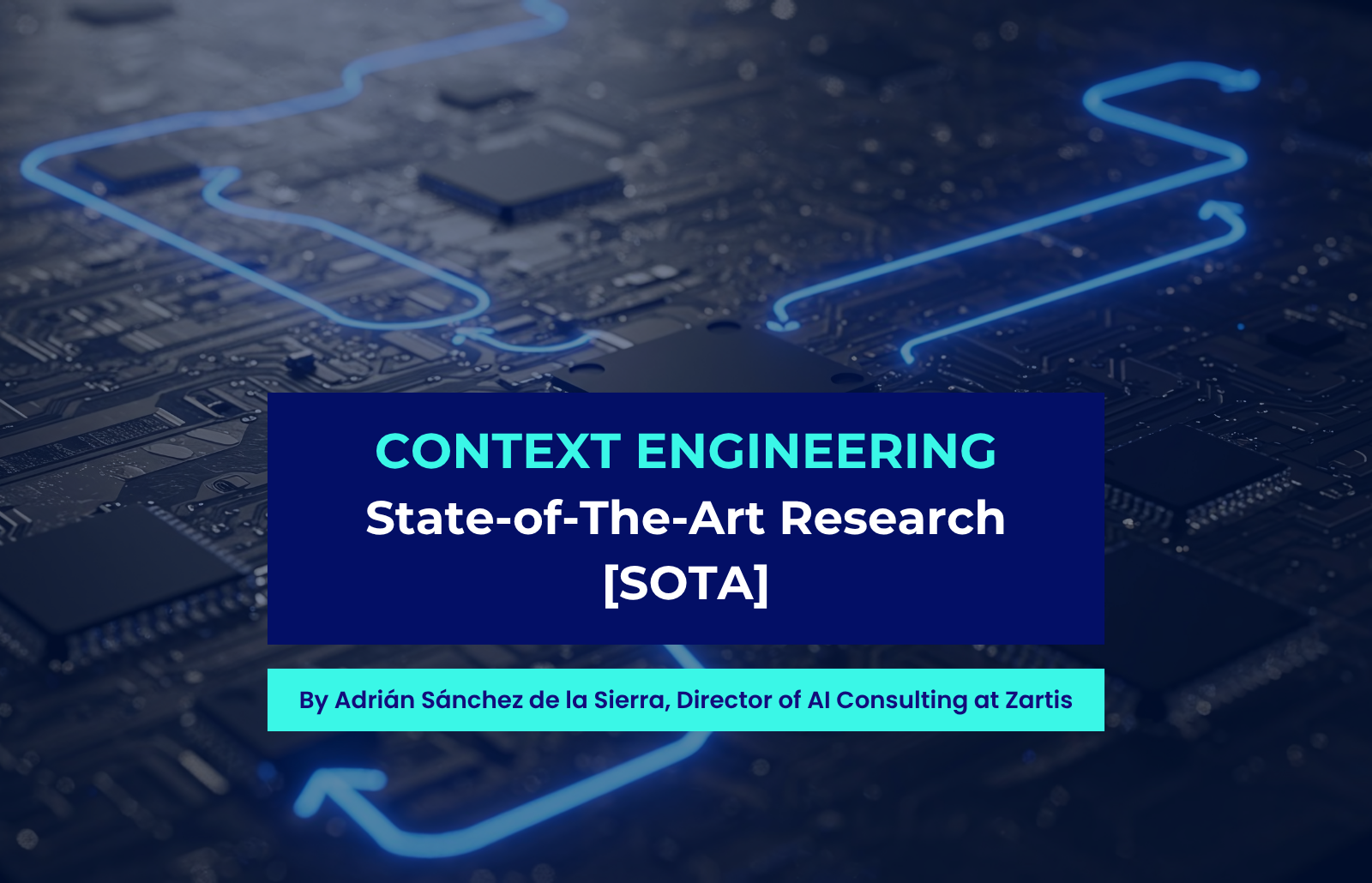Note: this is a survey of State-of-The-Art (SOTA) research and practices about context engineering. This is not a systematic scientific research, but an industry focused report.
TL;DR
Context engineering combines retrieval, memory, tool integration, and prompt design to keep LLMs accurate and stateful. Practical enterprise deployments use RAG, vector DBs, versioned or persistent memories, agent orchestration, and operational protocols to scale, secure, and govern agentic systems.
Core techniques
Context engineering for LLMs and agents centers on orchestrating where context comes from, how it is summarized and stored, and how it is fed into models; practitioners must combine retrieval, memory, processing, and tool integration to deliver reliable outputs. The following techniques are the foundational toolkit for production systems.
| Technique | Purpose | Practical note |
| Retrieval‑augmented generation (RAG) | Inject external facts at inference time | Use semantic search + vector DB to scope and cache relevant context |
| Long‑term memory systems | Preserve state across sessions | Implement tiered memories (short context, episodic, archival) and checkpoints |
| Tool and API integration | Let models act and verify via deterministic systems | Use tools for I/O, DB queries, and deterministic checks to reduce hallucination |
| Context versioning | Manage experiments and branching plans | Use Git‑like commit/branch semantics for agent memory to checkpoint and hand off state |
| Context runtime management | Maintain execution context and local state for code agents | Integrate runtime context managers that persist bindings and isolate local variables |
| Multi‑agent orchestration | Route tasks to specialized agents (router, retriever, coder, tester) | Dynamically pick retrieval and reasoning strategies per query to improve relevance |
Key evidence from recent work shows that formalizing these components (retrieval, generation, processing, management) produces robust systems rather than relying on ad‑hoc prompt patches. [2] Embedding domain knowledge, vector indexing, and caching materially reduce cost and hallucination risk in practice. [1]
Prompt best practices
Effective prompt engineering remains essential even in tool‑integrated systems; prompts should be explicit, structured, and monitored with feedback loops. Executives should mandate templates, testing, and automated tuning to ensure consistency and repeatability.
- Structure inputs Use layered prompts (system/instruction/examples) and explicit output schemas to reduce variability. [6]
- Use examples Few‑shot and role prompts stabilize behavior for domain tasks and can be automated or searched for optimal exemplars. [6]
- Chain prompts when needed Break complex tasks into prompt chains or reasoning traces (chain‑of‑thought) to improve stepwise correctness. [6]
- Embed business rules Encode workflow and guardrails in conversation routines so domain experts can own logic while engineers provide tool APIs. [7]
- Automatic tuning Implement prompt tweaking and feedback‑learning loops to iterate templates based on real usage metrics. [8]
Operational checklist for prompt governance
- Design: canonical templates + test cases. [6]
- Validate: automated score functions and human review for edge cases. [6]
- Iterate: capture failures and feed them into prompt tuning pipelines or few‑shot exemplar updates. [8]
Claims about best practices and automated instruction selection are supported by multiple systematic surveys and applied frameworks that show prompt ordering, clarity, and automated selection materially affect outcomes. [6][7]
Agent specific techniques
Agentic systems require persistent, composable context and explicit protocols so autonomous workflows remain coherent over long horizons. Practical patterns aim to offload, version, and orchestrate context across agents.
- Versioned memory Treat agent memory like a VCS (COMMIT, BRANCH, MERGE) so agents can checkpoint plans, explore alternatives, and recover milestones. [3]
- Persistent runtime context Preserve program‑level state and isolate local variables so generated code and subsequent reasoning see the same execution environment. [4]
- Hierarchical task decomposition Use planner→executor DAGs to break objectives into subtasks and preserve subtask state across retries. [8]
- Specialized agent roles Split responsibilities (planner, retriever, coder, debugger, reviewer) and route via a router agent to align model strengths with subtasks. [5][9]
- Context offloading and compression Move older or low‑value context to archival stores and compress summaries for the model input window to avoid drift and token overload. [2]
These methods have been shown to improve agent reliability in multi‑agent code and QA systems where dynamic retrieval and role decomposition increased accuracy and maintainability. [5][9][4][3]
Performance optimization
Scaling context‑heavy systems requires cost and latency controls plus adaptive retrieval so LLM usage is efficient and accurate. Focus on retrieval economics, caching, and selective context injection.
- Vector DB caching Cache semantically retrieved passages to reduce repeated LLM calls and lower per‑query cost.[1]
- Router‑based retrieval Route queries to specialized retrievers or SQL agents to reduce irrelevant context and speed responses.[5]
- Context selection and summarization Pre‑filter and compress long documents into concise evidence snippets or summaries before model input to fit token limits and reduce noise.[2]
- Protocol efficiency Use standardized context exchange protocols to minimize engineering friction and enable lightweight transports (HTTP/WebSocket) between agents and data sources.[10]
- Automated prompt tuning Continuously optimize prompt templates and sampling parameters using performance signals and prompt‑tweaking engines to improve throughput and correctness. [8]
Applied systems demonstrate that combining vector caching, adaptive retrieval, and protocol standardization reduces costs while maintaining relevance for enterprise workloads. [1][5][10][8]
Enterprise considerations
Executives must treat context engineering as both a technical and governance discipline: secure data flows, standards, roles, and human oversight are essential for production adoption. Implement patterns that separate domain design, engineering, and compliance responsibilities.
- Standardize context exchange Adopt a model context protocol to unify how prompts, tools, and resources are presented to agents and to enforce security boundaries. [10]
- Mitigate hallucination Combine fine‑tuning or embedding domain knowledge with RAG and post‑tool verification to reduce incorrect outputs in regulated domains. [1]
- Role separation Let domain experts craft conversation routines and prompts, while engineers implement vetted tool APIs; this lowers risk and speeds iteration. [7]
- Industry pilots and measures Use operational case studies (e.g., industrial test‑maintenance pilots) to validate multi‑agent architectures, measure triggers and failure modes, and collect governance telemetry before wide rollout. [11]
- Privacy and compliance Where data residency matters consider federated learning or on‑prem vector stores and strict access control for retrieved context. [1][12]
For enterprise rollout, require SLOs for factuality, audit logs for context provenance, and fallback deterministic services for high‑risk decisions to maintain liability containment. [10][11]
Common challenges and solutions
Context engineering faces recurring problems: hallucination, context window limits, semantic drift, nondeterminism, and operational cost — each has practical mitigations.
- Hallucination Mitigation: prefer retrieval + tool verification; fine‑tune domain facts; implement deterministic post‑checks for critical outputs. [1]
- Context window limits Mitigation: tiered memories and selective summarization or compression; offload archival context with versioning/branching for long workflows. [2][3]
- Semantic drift and inconsistency Mitigation: periodic re‑summarization, commit/merge checkpoints, and explicit memory refresh policies. [2][3]
- Non‑deterministic behavior Mitigation: enforce output schemas, use deterministic tools for critical steps, and add automated test suites and oracle checks in agent loops. [7][8]
- Compute and cost overhead Mitigation: vector caching, router agents to avoid unnecessary LLM calls, and protocol efficiency to reduce payload duplication. [1][5][10]
These solutions are validated across surveys and applied frameworks showing that engineering memory and retrieval layers is more effective than only altering prompts. [2][1][3]
Emerging trends and directions
Practical roadmaps for leaders should prioritize standardization, modular memory, and automation in prompt/context tooling while watching for research advances that change economics. Several near‑term trends will reshape operations.
- Context protocols and standards Growing adoption of Model Context Protocols to standardize secure, real‑time context exchange across services. [10]
- Versioned agent memory Git‑style memory controllers and programmatic context versioning will enable reproducible agent experiments and handoffs. [3]
- Code‑driven agent OS Frameworks that integrate runtime context with code generation let agents evolve safely and reduce prompt complexity. [4]
- Automated prompt generation Auto‑generated instructions and selection procedures will reduce manual prompt maintenance and scale domain templates. [6]
- Privacy‑preserving architectures Federated and on‑prem retrieval models combined with RAG will enable sensitive‑data use cases at scale. [1][12]
Leaders should invest in modular context infrastructure (vector stores, memory controllers, standardized protocols), operational tooling (testing, monitoring, prompt‑tuning pipelines), and governance (auditability, role separation) to convert these trends into secure, scalable business value. [10][1][3][6][4]
–
Written by Adrian Sanchez de la Sierra, Head of AI Consulting at Zartis.
At Zartis, we help organizations design AI strategies that are disciplined, measurable, and aligned to business goals. Reach out today to discuss how we can help your team!
References
[1] V. Ayyagari, “Model Context Protocol for Agentic AI: Enabling Contextual Interoperability Across Systems,” International journal of computational and experimental science and engineering, vol. 11, no. 3, Aug. 2025, https://ijcesen.com/index.php/ijcesen/article/view/3678
[2] “Pioneering Autonomous Penetration Testing with Large Language Models through Prompt Engineering and Agentic System Design”, [Online]. Available: https://search.proquest.com/openview/11b5bbf99421d95d9cc8c188a022f67f/1?pq-origsite=gscholar&cbl=18750&diss=y
[3] M. Haseeb, “Context Engineering for Multi-Agent LLM Code Assistants Using Elicit, NotebookLM, ChatGPT, and Claude Code,” arXiv.org, vol. abs/2508.08322, Aug. 2025, https://arxiv.org/abs/2508.08322
[4] “Dynamic Multi-Agent Orchestration and Retrieval for Multi-Source Question-Answer Systems using Large Language Models.” [Online]. Available: http://arxiv.org/abs/2412.17964v1
[5] “Scaling Data Driven Building Energy Modeling Using Large Language Models: Prompt Engineering and Agentic Workflow”, [Online]. Available: https://search.proquest.com/openview/749601c9da2bec5a8b35b42ffe96f20b/1?pq-origsite=gscholar&cbl=18750&diss=y
[6] A. Omidvar and A. An, “Empowering Conversational Agents using Semantic In-Context Learning,” Jan. 2023, https://aclanthology.org/2023.bea-1.62/
[7] L. Lemner, L. Wahlgren, G. Gay, N. Mohammadiha, J. Liu, and J. Wennerberg, “Exploring the Integration of Large Language Models in Industrial Test Maintenance Processes,” Sept. 2024, https://arxiv.org/abs/2409.06416
[8] S. Barua, “Exploring Autonomous Agents through the Lens of Large Language Models: A Review,” Apr. 2024, https://arxiv.org/abs/2404.04442
[9] G. Robino, “Conversation Routines: A Prompt Engineering Framework for Task-Oriented Dialog Systems,” Jan. 2025, https://arxiv.org/abs/2501.11613
[10] “Enhancing Requirements Engineering Practices Using Large Language Models”, [Online]. Available: https://gupea.ub.gu.se/handle/2077/83054
[11] “Autonomous Deep Agent.” [Online]. Available: http://arxiv.org/abs/2502.07056v1

